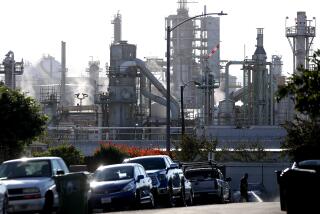Betting on a Berlin boom
A glimpse of this city’s real estate pages suggests that just about anything’s for sale: A Brit is turning a former Hitler Youth headquarters into a luxury club, Americans have bought up swaths of former communist-era apartment buildings, a German firm has transformed a red-brick prison into condos, and owners of rooftop flats have never been more coy.
“The scent is out to buy in Berlin,” said Hans Peter Plettner, chief of a property auctioning company, who sat in his office the other day with a pedigreed boxer sleeping at his feet. “The real estate prices in the city are lower than in Budapest and Prague. That’s strange but true. Berlin is being marketed and it’s on everyone’s tongue. It’s the talk of the West.”
Hipper and cheaper than Paris and Rome, and the capital of Europe’s economic power, Berlin is attracting investors from around the world.
Commercial, industrial and residential sales revenue jumped 58% from 2005 to 2006, from $12 billion to $19 billion. The number of property purchasing contracts rose from 18,000 in 2004 to 27,000 last year.
Speculators from Scandinavia, Ireland, Britain, France, Russia and the United States have been drawn by low-interest loans, some of the most generous tax incentives on the continent and property rates that can be about half the price of those in other European capitals. Investors are also betting that as the European Union expands eastward, Berlin will become an important arts and business center.
Dismaying bottom line
There are the annoying facts of the city’s high unemployment rate and huge debt, but Berlin’s image as a cultural and party haven has, at least for now, more verve than its rather dismaying bottom line.
“Berlin moved into international focus over the last 10 years, but we’ve had hyperactivity in the last two years,” said Sebastian Kohlmeyer, a fashion designer-turned-real estate agent. “Berlin is a city always on the move. It wants to be something, but it’s really not searching for a definition. It offers a kind of anarchy that dares you to do things you might not dare to do in other cities.”
No longer divided, Berlin emerged from the Cold War as a place that held a fascination for bohemians looking for cheap digs. The Love Parade, a clamor of techno-pop and hedonism, added a risque marketing twist; neighborhoods such as Mitte became the domains of expats from Stockholm to Des Moines. In 1999, Berlin once again became the German capital, elbowing aside staid Bonn, and many hoped the city would revive the decadence, clout and charm it enjoyed before the rise of fascism more than six decades earlier.
The politicians and the artists came, but prosperity didn’t. With a debt of $83 billion, Berlin epitomizes the costly, unfinished task of economically uniting east and west. The city lacks significant industry and core businesses, and although the overall German economy is expanding after years of stagnation, Berlin is streaked with graffiti and dotted with closed factories and abandoned mills.
“At the moment we have no long-term signs that Berlin will enjoy economic growth,” said Thomas Sandner, a property assessor in the city planning office. “We don’t want to wipe the mood away, but we’re still waiting for a better business climate.”
‘Poor, but sexy’
The risks for speculators are many. Investors essentially are gambling that Berlin’s image will sustain the city until the economy catches up. There also are doubts about whether Germany’s strict rental laws will allow foreign landlords to raise rents enough to justify their expenditures on renovations.
Such concerns, however, have yet to deter large equity and investments firms, or the small investors and single buyers who have followed them. All of these have been seduced by the city’s zeitgeist, which Mayor Klaus Wowereit characterized as “poor, but sexy.” Wowereit, who is gay, has marketed the city as one of Europe’s homosexual bastions. Known for generations for its world-class orchestras, KitKat Club and cabarets, Berlin has an insatiable nightlife, low crime rate and, not surprisingly, dependable public transportation.
To understand Berlin’s allure one need only stroll through Prenzlauer Berg. This former East German neighborhood, once smeared with brown coal smoke, is one of the city’s most popular draws.
Renovation and gentrification have brought blond wood floors and stainless steel designer ovens that cost more than a communist worker made in a year, maybe two.
“I was born in this neighborhood, but it’s not the same place,” said Kohlmeyer, sitting in a cafe with his business partner, Lutz Herbert. “I’m living in a completely different city without having moved.
“Twelve years ago, Berlin was a big lie. Companies came and opened offices here, but nothing was happening and many couldn’t afford it. The media exaggerated Berlin as Europe’s next big capital. But now that old lie appears to be coming true and the companies are trying to hold on.”
Kohlmeyer and Herbert, a writer, founded their real estate company five years ago.
“None of us were in this business before,” Kohlmeyer said, “but now we have a team of nine people, including a former punk. We knew what was happening. We saw the trend.”
“You can still have a very good French lunch in Berlin for 10 euros,” about $13.50, Herbert said. “Where else can you find such a thing? Not even in France.”
The neighborhood clatters with bikers, artists, accountants, cement mixers and window washers. It has its rough edges and there is a taste of the avant-garde, but one gets the feeling, amid the buffed brick and new facades, that the Goths are giving way to the khaki crowd.
Apartments on some streets are anything but bohemian: A four-room flat offered by Herbert and Kohlmeyer for more than $335 per square foot in 2006 is likely to get $418 per square foot this year.
*







